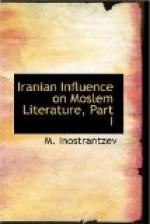in Istakhar called Darbesht and he appointed herbeds
in that connection. He prohibited the teaching
of it to ordinary people.... [Here follows a passage
which is not very clear regarding the difference that
arose between the king of Iran and the king of the
Turks relating to this new religion which Bishtasb
had adopted. The name of the Turk sovereign is
given as Khurzasaf.] Now when the messenger arrived
with the epistle to Bishtasb there were gathered together
the Ahl-bayat[1] and the noblemen of the empire, including
Jamasaf the Wise, and Zarrin son of Loharasaf.
Then Bishtasb wrote to the king of the Turks a strongly
worded reply challenging him to a war and expressing
his determination not to withdraw the step that he
had taken and saying that that even if he refrained
from fighting there would be all the people on both
sides who would continue the struggle. On that
day there were in the council of Bishtasb his brother
Zarrin, and Nastur son of Zarrin, and Isfandiyar and
Beshotan, the sons of Bishtasb and all the progeny
of Loharasb. On the side of Khorasaf there were
Ju Hormaz, and Hudarman his brother, and the Ahl-bayat
and Baidarafsh, the magician. In the battle Zarrin
was killed which was a heavy blow to Bishtasb and
a great booty was taken by his son Isfandiyar, and
Baidaraf was killed which was a calamity to the Turks.
There was a huge slaughter and Khorsasaf fled.
Thereupon Bishtasb returned to Balkh. Now when
a number of years had passed after this war a person
called Karzam attacked Isfandiyar. There was also
an estrangement between Bishtasb and Isfandiyar.
Order was issued for his imprisonment in a castle
in which there were ladies, Bishtasb then proceeded
in the direction of Kerman and Sagistan and proceeded
towards a mountain called Tamdar. [The various manuscripts
write the word differently and the editors have printed
it without the diacritical marks so that it can be
read in a variety of ways], for the purpose of teaching
the religion and of spreading it there. And he
left behind him his father Loharasaf in the city of
Balkh and the treasures and the properties along with
the harem including Khatus, his queen, were also left
with the old man. [As the Editor points out Khatus
is the Hutaosa of Gosh Yast 26, and Ram
Yast 36[2]]. Now this fact was conveyed by
the spies to Khorasaf and when he learnt it he collected
an innumerable army and proceeded from his country
towards Balkh and Khorasaf thought that this was an
opportunity of attacking Bishtasb and his country.
Thus when he approached Takhun he sent forward Ju
Hormaz, his brother, with a large army and directed
him to continue his march till he reached the centre
of Bishtasb’s country and to invade it and attack
the people and the cities. And this was done
by Ju Hormaz who shed a large amount of blood and
carried off incalculable booty. And Khorasaf followed
him and set fire to the archives and slew Lohorasaf
and the herbeds and destroyed the fire-temples,
(buyut-an-niran) and he took possession of
the properties and the treasuries and took two of the
daughters of Lohorasaf prisoner and one of them was
called Khumay and the other Bazafreh. [This of course
is according to Firdousi Beh Afrid]. He captured
a great standard which was called Dirafsh Kabyan and
he pursued Bishtasb who was fleeing from him.




